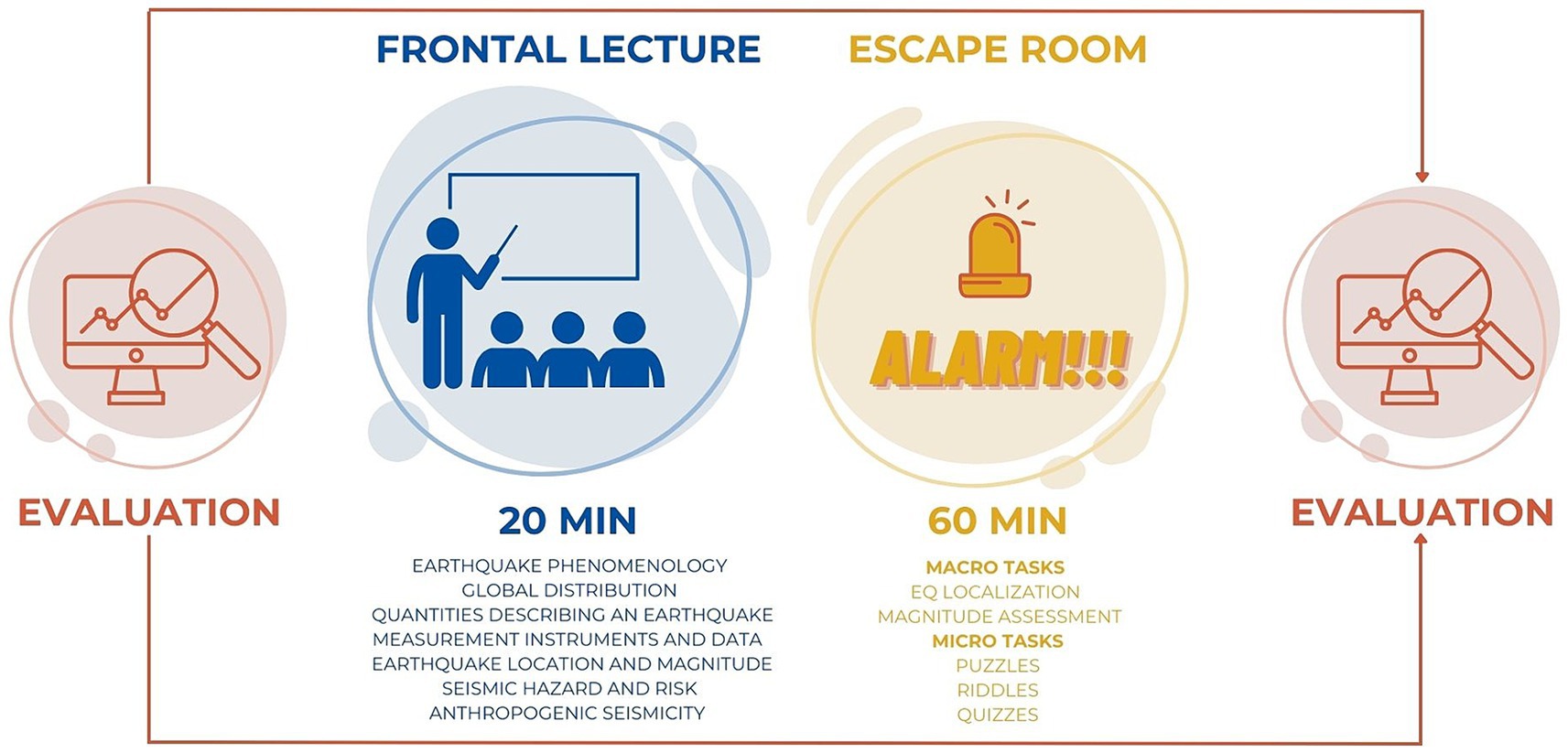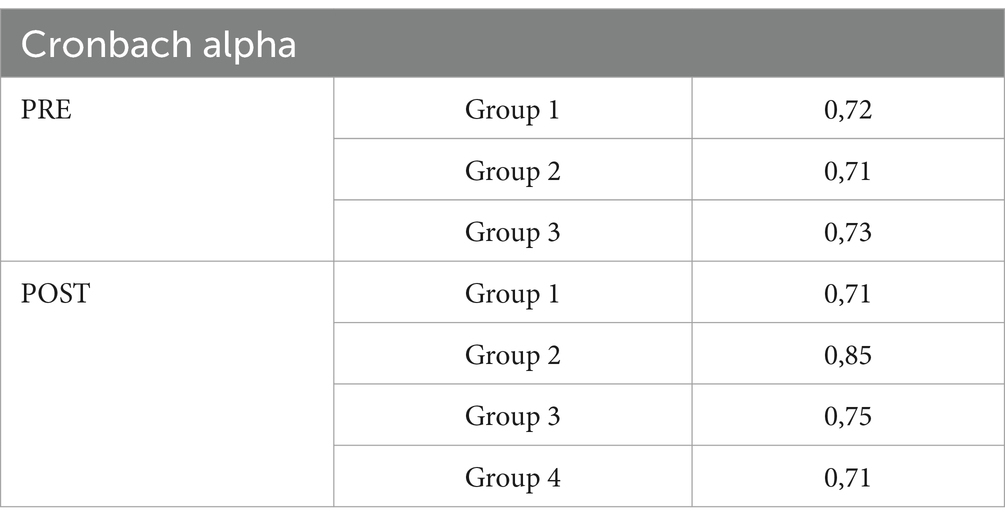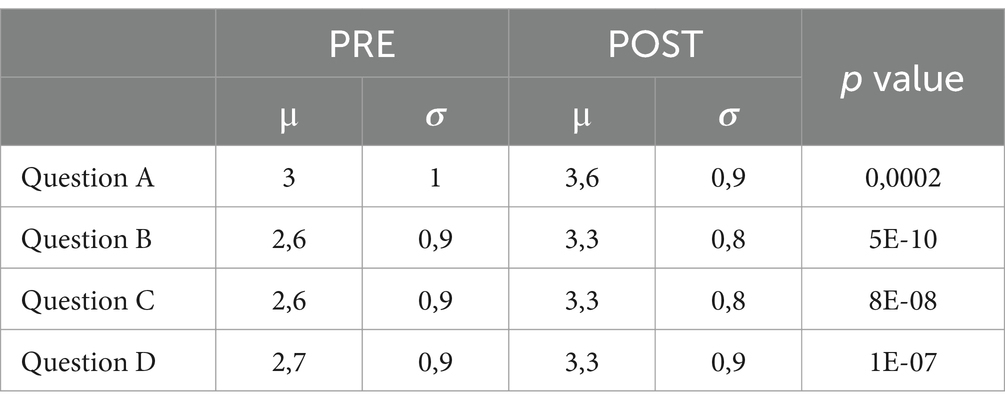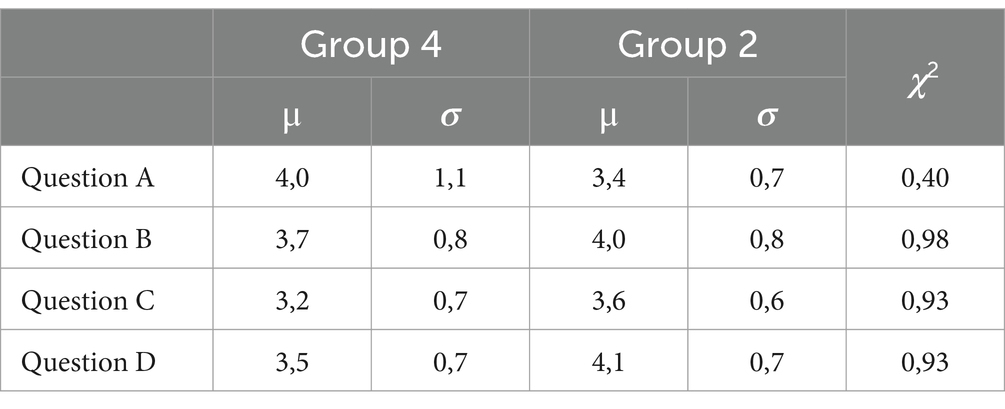- Dipartimento di Fisica “E.R. Caianiello”, Università degli Studi di Salerno, Fisciano, Italy
Effective risk communication is crucial for enhancing societal resilience. It’s not just about scientific strategies; it’s also about ensuring that communities are informed and prepared. Educating local populations, especially younger generations, is key to improving disaster readiness. Notably, engaging younger generations assumes significance, given their role as both the future of society and conduits for educating their families. Serious Games, specifically Escape Rooms, present a compelling tool for engaging and interacting with young people. These games, designed not primarily for entertainment but for educational purposes, facilitate active participant involvement, thereby enhancing learning. In our didactic approach, comprising a frontal lesson and an Escape Room, we sought to leverage the appeal of Serious Games to educate young people. This approach was particularly timely during the COVID-19 pandemic, where virtual experiences gained positive evaluations despite the inherent challenges. Italy frequently faces large magnitude earthquakes. Yet many Italians, especially young people, have low seismic risk awareness, hindering preparedness efforts. To address this issue, the use of games and interactive experiences proves promising. By involving young people, seismic risk awareness can be effectively raised, fostering a culture of safety. Throughout the implementation of the Escape Room exercise dedicated to seismic risk, we conducted an evaluation phase both before and after the activities. The insights gained from this evaluation process provided valuable feedback on the learning experience and the effectiveness of the science communication technique. Notably, the virtual nature of the escape room experience was positively evaluated, demonstrating its adaptability during the pandemic. It is imperative to acknowledge that participants in these activities were aged between 15 and 18 years old, requiring ethical considerations in the design and execution of the educational intervention. The findings are highly promising, indicating that students viewed the protocol as beneficial for understanding fundamental concepts in seismology and enhancing their perception of risk. Moreover, the protocol positively influenced students’ interest in science and geophysics. Furthermore, an aspect that remains unexplored is the extent to which the knowledge acquired by the participants was disseminated within their families, representing a potential area for future investigation.
1 Introduction
Effective science communication is increasingly vital for ensuring the societal impact of research. Today, the deluge of information constantly flowing through social media and the internet significantly influences how citizens perceive science and shapes their behaviour (Lewandowsky et al., 2017; Fernandez and Alani, 2018; Lazer et al., 2018; Lewandowsky and van der Linden, 2021). The efficacy of risk mitigation does not rest solely on the scientific community; it relies equally on society’s readiness and knowledge regarding these risks (Coombs and Holladay, 2012; Wendling et al., 2013; Katsikopoulos, 2021; Torpan et al., 2021). Therefore, it’s imperative to educate local populations, enhancing disaster risk preparedness and bolstering societal resilience (Reuter and Spielhofer, 2017; Reuter et al., 2019; Appleby-Arnold et al., 2021).
The younger generation assumes a pivotal role in elevating scientific awareness within society. They represent both the future of our communities and a conduit to reach and educate their families (Mitchell et al., 2008; Fernandez and Shaw, 2013). Moreover, studies indicate that the youth exhibit a keen interest and awareness in addressing major global issues, such as the COVID-19 pandemic (OCED, 2020; Jun et al., 2021; UNESCO, 2022). Consequently, harnessing their traits and passions, such as their openness to change and robust sense of responsibility, can prove to be a successful approach for fostering scientific awareness in the community (Jun et al., 2021). In this context, the utilisation of Serious Games, rooted in the “learning by doing” philosophy, is gaining momentum in STEM (Fotaris and Mastoras, 2019; López-Belmonte et al., 2020; Veldkamp et al., 2020, 2021; Lathwesen and Belova, 2021). Among all these applications, it becomes of paramount importance for countries characterised by high seismic hazard to educate and inform the public, and particularly the younger generations, about seismic risk, also making use of Serious Games (Alexander, 2014; Dryhurst et al., 2022; Dallo et al., 2023). Over the last 20 years, there has been a remarkable transformation in the field of seismic risk communication. Thus, transformation has shifted the focus from a primarily one-sided, top-down communication approach to one that prioritises individuals, their requirements, and their involvement in disaster risk management (Musacchio et al., 2023).
Italy is a country with a long history of seismic activity, with numerous earthquakes occurring throughout its territory. However, the perception of seismic risk among the Italian population, particularly among young people, is often inadequate. Studies have shown that many Italians underestimate the likelihood and potential impact of earthquakes, leading to a lack of preparedness and a false sense of security (Crescimbene et al., 2018).
This issue is further exacerbated by the current information overload dictated by social networks. The rapid dissemination of information, often unverified or sensationalised, can contribute to the spread of misinformation and a distorted understanding of seismic risk (Dallo et al., 2023). This can lead to a decreased attention threshold, making it more challenging to effectively communicate the importance of seismic risk preparedness (Chmutina and von Meding, 2019).
To address this challenge, the proposed method of utilising games and interactive experiences can be a valuable tool. By engaging young people in a more immersive and participative way, the authors can effectively convey the importance of seismic risk preparedness and foster a culture of safety and responsibility. This approach can help to overcome the attention threshold issues posed by social media and provide a more effective means of communicating complex scientific information.
However, it is crucial to recognize that the efficacy of risk mitigation efforts goes beyond the scientific community and the use of innovative communication methods (Federal Emergency Management Agency, 2009). Law enforcement and regulatory bodies play a pivotal role in ensuring the implementation of effective seismic risk management strategies (Meesters and Van Aalst, 2014). By collaborating across these domains, the scientific community can leverage the expertise and resources of law enforcement and regulatory bodies to enhance the overall effectiveness of risk mitigation efforts (Comfort, 1999; Kapucu, 2008; Coppola, 2015; Paton, 2019).
For example, law enforcement can play a vital role in ensuring compliance with building codes and regulations, ensuring that structures are designed and constructed to withstand seismic events. Regulatory bodies, on the other hand, can establish and enforce policies that promote seismic risk preparedness, such as mandatory earthquake drills in schools and public buildings (Spence, 2004; Tierney, 2019). By promoting a culture of safety and responsibility that encompasses all stakeholders, including the scientific community, law enforcement, and regulatory bodies, Italy can enhance its collective ability to mitigate seismic risks and create safer environments for its citizens with a bottom-up approach to resilience.
Indeed, in recent times, there has been a growing recognition of the significance of bottom-up approaches to risk education. This has elevated the role of Serious Games as a viable option in supplementing educational tools for improving abilities needed to respond collaboratively and adaptively to social and ecological challenges (Musacchio et al., 2016; Solarino et al., 2021).
Numerous instances of Serious Games have been already applied in Italy in the field of seismic risk education (Musacchio et al., 2015, 2019; Reitano et al., 2019; Piangiamore et al., 2021; Falsaperla et al., 2022; Filomena et al., 2023), but these examples are typically part of extensive seismic risk awareness campaigns and projects, while the experience developed in this work is a one-time endeavour. Consequently, it is more accessible for testing and replication, and it primarily serves as a means to pique and stimulate the students’ interest in the topic, rather than to establish enduring knowledge. Traditional methods of teaching seismic risk often struggle to captivate the attention of young learners. In an era where distractions abound, and the learning process can feel monotonous, innovative, stimulating, and engaging approaches are necessary to ensure that the importance of seismic risk is not overshadowed.
Within this context, during the academic year 2020/21, due to the restrictions caused by the COVID-19 pandemic, we encountered the necessity to adapt our orientation and engagement activities with schools to virtual platforms approved by the schools themselves. Our objective remained to maintain a light interactive experience while fostering informal learning. We took the opportunity to use a novel educational approach—an escape room experience designed to educate high school students about seismic risk, that we present in this paper. This didactic endeavour introduces a fusion of education and entertainment, leveraging the concept of “serious games” to engage young minds. The serious game presented in this work serves as a powerful vehicle for knowledge transmission while infusing an element of excitement into the learning process.
The escape room experience, following a short frontal lecture to introduce the basic notions to be used later on, immerses students into an interactive world where they must grapple with the challenges and decisions inherent to seismic risk. It offers a compelling narrative, puzzles, and scenarios that mimic real-life situations. Through this experiential learning approach, students are placed at the centre of activities, directly observing how the knowledge they gain can be practically applied in case of a seismic event occurrence, of which they estimate location and magnitude.
To help them relate with the experience, students are offered a regional case study. While the selected case study area may have experienced strong earthquakes in the past, the relative calm in seismic activity over the last 40 years might inadvertently lead to reduced attention from newer generations who have not directly encountered significant tremors. This does not mean that the area would not experience strong earthquakes in the future. Thus, the selection of a case study area, interested by past large magnitude events, located nearby the students’ residences expressly aims to increase awareness and understanding of seismic risks of the region, particularly among those who may not have experienced such events first-hand.
We show the impact of the experience proposed in this work on high school students, by evaluating the before-and-after knowledge and perceptions of the participants through Cronbach (1951), and t-Student tests (Student, 1908), demonstrating an improvement of the pupils’ interest in the topic. These results highlight that a single session in a virtual escape room can effectively raise awareness of seismic risk and cultivate a lasting interest in the subject. However, it is essential to acknowledge that sustainability is a challenge in this context. A single experience, however impactful, must contend with the constant barrage of information and stimuli that students encounter. Nevertheless, the potential for this innovative approach to serve as a stepping stone toward better understanding seismic risk is a compelling reason for its exploration. In fact, the ‘one-time endeavour’ protocol in seismic risk communication presents a unique approach that emphasises a singular, intensive effort to engage and inform individuals about seismic risks. This protocol stands out for its focus on creating a significant impact through a concentrated educational experience rather than relying on continuous educational programs. By stimulating interest and awareness in a condensed manner, this approach aims to promote preparedness effectively. Research by Nazli (2018) highlights the importance of effective disaster communication in crisis situations, emphasising the need for clear and impactful messaging to guide response efforts.
While the literature predominantly supports ongoing educational initiatives, the ‘one-time endeavour’ protocol offers a fresh perspective by suggesting that a singular, intensive experience can be more replicable and impactful in stimulating interest and preparedness (Musacchio et al., 2019, 2021, 2023; Falsaperla et al., 2022; Filomena et al., 2023). This approach may be particularly beneficial in scenarios where continuous educational programs are challenging to implement or sustain. Although international examples of similar protocols are limited in the literature, the theoretical framework on disaster communication by Nazli (2018) emphasises the interactive nature of disaster communication, supporting the idea that a focused, stimulating experience can effectively engage individuals and communities in preparing for seismic risks.
2 Methods
In the following subsections we will describe in detail the protocol used, that is how the experience was carried out, the data and the statistical analysis used to assess the impact of the experience on the attendees.
The method we propose has been specifically designed as an interactive lesson to be aimed at secondary school students, i.e., students who have basic knowledge of physics, mathematics, and geography. The method of implementation is suited for both frontal and remote lessons. The tools to be used are: (i) an online platform where to perform the lesson and the escape room, such as Google Meet; (ii) an open source software for the analyses of seismogram, such as Java programme SeisGram2K1; and (iii) survey tools.
The procedure we propose consists of three pillars: lecture, escape room and data collection (Figure 1). In the following paragraphs we detailed each step of the procedure.
2.1 Frontal lecture
The lesson is organised as a frontal lecture, slides are used for visual support. We suggest that the total duration should be approximately 15–20 min long. During this time block, the goal would be to provide the attendees a lesson covering both natural and anthropogenic seismic risks, and would delve into the complexities of earthquake hazards, including both those triggered by natural processes and those influenced by human activities. The topics covered in the frontal lecture on natural and anthropogenic seismicity are designed to enhance risk awareness and address potential knowledge gaps among the attendees. The title of the lesson we performed is “The natural and anthropogenic seismicity.” The content of the frontal lecture is developed according to the following points
1. Basic concept about the earthquake phenomenology and their global distribution;
2. Quantities describing an earthquake;
3. Measurement instruments and data (with examples related to the case study that will be analysed during the escape room);
4. Earthquake location and magnitude;
5. Seismic hazard and risk;
6. Anthropogenic seismicity due to georesource exploitation.
The following is a description of the topics covered, specifying the purpose, how they are related to risk awareness and what are the possible knowledge gaps to fill.
2.1.1 Basic concept about earthquake phenomenology and global distribution
The aim of this part of the lecture is to provide general information on the nature of earthquakes, by using a scientific vocabulary that is comprehensible to high school students. Furthermore, the earthquakes are shown as global scale phenomena due to the dynamics of the Earth system. During the lesson we introduce the concept of seismic waves, explaining the different types of seismic waves (P-waves, S-waves, surface waves) and how they propagate within the Earth. We discuss plate tectonics, faulting, and volcanic activity. Moreover we highlight the global distribution of earthquakes, identifying relevant seismic regions along tectonic plate boundaries and areas with high seismic activity. Understanding the basics of earthquake phenomenology helps attendees grasp the fundamental nature of seismic hazards, enabling them to recognize the potential risks associated with living in earthquake-prone regions (risk awareness). By providing this information, the lecture bridges knowledge gaps and ensures attendees have a solid understanding of seismic processes worldwide filling possible knowledge gaps. In this type of approach, it is not recommended to use images and videos that show the harmful effects (Societal Resilience Cluster, 2023).
2.1.2 Quantities describing an earthquake, measurement instruments and data and earthquake location and magnitude
The aim of these sections is to provide elements and instruments to estimate location and magnitude of an earthquake. The choice of earthquake location is not left to chance. Many schools come from the Campania region (Southern Italy), which in a broader picture of high seismic risk in Italy, was the site of one of the strongest earthquakes in Italian history, the MS 6.9 Campania-Lucania earthquake of 23 November 1980 (also called Irpinia earthquake). This zone experience repeated seismic activity due to the release of accumulated energy from tectonic plate pressures and the present-day seismicity is characterised by low-magnitude events (Ml < 4.0) and monitoring by the Irpinia Seismic Network.2 Referencing recent earthquakes in the region serves as a powerful illustration of the recurrence of seismic activity in specific areas. These zones experience repeated earthquakes due to the ongoing release of accumulated energy from tectonic plate movements and interactions. By highlighting the occurrence of recent seismic events in these regions, attendees can understand that earthquakes are not isolated incidents but rather part of a broader pattern of geological activity. This notion stimulates the reflection on the importance of utilising time wisely to prepare people in case of future seismic events.
The idea of locating a more recent earthquake but in the same area devastated by the 1980 earthquake, certainly could lead to an increase in awareness of the seismic risk of one’s own territory and encourages a discussion about it. Communities in earthquake-prone areas must remain vigilant and proactive in implementing preparedness measures, including building resilience in infrastructure, developing emergency response plans, and fostering public awareness. Understanding the historical context of seismic activity in the region emphasises the need for continuous efforts to mitigate risks and enhance preparedness, ensuring the safety and well-being of residents in earthquake-prone areas.
The proposed scheme allows the student to familiarise with the seismograms, the seismometers and the mathematical equations for the estimate of earthquake location and magnitude. To this aim, given the age and the pupils’ school background, we illustrate simple techniques that do not make use of iterative algorithms: the three-circles method for earthquake location estimate and the maximum amplitude S-phase reading to be included in a simple equation for calculating the local magnitude (Havskov and Ottemöller, 2010). Moreover, the waveforms shown were recorded at one of the sites of major seismic interest, closest to the student’s territory. Learning about earthquake magnitude and intensity scales enables attendees to interpret seismic information effectively. This knowledge is crucial for assessing the severity of earthquake impacts and understanding their potential consequences. Familiarity with seismometers and seismograms enhances attendees’ awareness of earthquake monitoring and early warning systems. Knowing how seismic data is collected and analysed enables them to appreciate the importance of reliable information for risk assessment and mitigation. Understanding how earthquakes are located and the methods used to estimate their magnitude allows attendees to comprehend the spatial and temporal distribution of seismic activity. This awareness is essential for assessing local seismic hazards and planning emergency responses. Attendees may not be familiar with the various scales used to quantify earthquakes or understand the difference between magnitude and intensity. Addressing these concepts helps fill knowledge gaps and ensures attendees are equipped to evaluate earthquake risks accurately. Moreover, providing insights into instruments used to measure seismic activity and how seismic data is interpreted promotes a better understanding of earthquake monitoring and research. The techniques used to determine earthquake location and magnitude are generally not known only to those who have completed university studies in the scientific field. Addressing these concepts helps filling knowledge gaps and ensures attendees understand how seismic information is derived and applied in risk assessment.
2.1.3 Seismic hazard and risk
The aim of this part is to familiarise with the definition of seismic hazard as the probability of ground shaking exceeding a certain threshold within a specified time period, and explore seismic risk assessment, discussing the process of evaluating potential losses (e.g., structural damage, casualties, economic impact) due to earthquakes, emphasising the importance of risk mitigation strategies. A crucial point is to explore the hazard map available for the country, providing insights into reading the parameters in the area of interest. Exploring seismic hazard and risk concepts provides attendees with a framework for understanding the potential impacts of earthquakes on communities, infrastructure, and the environment. This awareness empowers them to identify vulnerable areas and prioritise mitigation efforts. Attendees may have limited knowledge of seismic hazard and risk terminology and concepts. By clarifying these topics, the lecture fills knowledge gaps and equips attendees with the tools to assess and mitigate seismic risks effectively.
2.1.4 Anthropogenic seismicity due to georesource exploitation
The aim of the last part of the lecture is to provide examples of human activities induced seismicity, discussing how activities like mining, reservoir impoundment, and fluid injection (e.g., hydraulic fracturing, wastewater disposal) can trigger earthquakes. We highlight the challenges and implications of anthropogenic seismicity, addressing regulatory issues, public concerns, and risk management strategies related to human-induced earthquakes. In this context, providing a focus on a specific area of interest is highly recommended. The discussion about anthropogenic seismicity raises awareness about the potential hazards associated with human activities. Understanding these risks is essential for informed decision-making and sustainable resource management. Attendees may not be aware of the link between human activities and induced seismicity or the potential consequences of such activities. Addressing these gaps in knowledge ensures attendees are informed about the complexities of anthropogenic seismic hazards and their implications for risk management.
The set of topics covered and discussed is of fundamental importance both to stimulate reflection on the concept of seismic risk and to provide the basic concepts and notions that will enable the attendees to solve puzzles and answer questions posed in the subsequent escape room, i.e., to continue to participate actively in the proposed educational experience. The frontal lecture can be found in the Supplementary material.
2.2 Escape room
The use of escape rooms as a tool for risk communication is a novel and innovative approach. Indeed, escape rooms provide an immersive and engaging environment where participants must work together to solve puzzles and challenges in order to “escape” the room within a set time frame (Nicholson, 2015). This interactive format allows for the effective communication of risk-related information in a memorable and experiential way, rather than relying solely on traditional lecture-based methods, touching not only the cognitive area but also the emotional one.
The design of educational escape rooms incorporates various didactic and pedagogical strategies to enhance the learning experience. The strategies we used to effectively communicate seismic risk-related information and enhance risk awareness include:
Experiential learning: escape rooms create a hands-on, problem-solving environment where participants actively engage with the content, fostering deeper understanding and retention (Kinio et al., 2019).
Collaborative learning: escape rooms encourage teamwork and communication, as participants must work together to overcome challenges, promoting the development of critical thinking and interpersonal skills (Cain, 2019).
Gamification: the game-like structure of escape rooms, with its elements of challenge, competition, and reward, can increase motivation and engagement, making the learning process more enjoyable and effective (Nicholson, 2018).
Adaptive difficulty: escape room puzzles and challenges can be designed with varying levels of complexity, allowing for personalised learning experiences that cater to different skill levels and prior knowledge (Kinio et al., 2019).
Essential to Gamification is a coherent story that accompanies the user from start to finish (Krath et al., 2021). In the case of the proposed escape room called ALARM (eArthquAke heLp mAgnitude epicenteR seisMologist), the story is that an earthquake occurred which resulted in the loss of memory of the technician in the monitoring room in charge of alerting the area for help. The players have the task of guiding the technician through the subsequent actions that will allow him to correctly identify the parameters of the earthquake, i.e., location and magnitude, and communicate them to the emergency services, who will then be able to intervene to support the affected population.
At the beginning of the escape room, a video is shown that contextualises the situation in which the user finds himself. The earthquake, the moments immediately following it in the monitoring room and the loss of the technician’s memory are reproduced. The players are then put in contact with the technician and the escape room begins.
The escape room, lasting around 1 h, consists of two macro tasks and five smaller tasks.
The macro tasks correspond to solving technical issues concerning the analysis of seismological data in geophysics (Figure 2):
1. the picking operation on the seismograms recorded at three seismic stations and the consequent location of the epicentre using the three-circles method;
2. the magnitude estimation of the event by analysing the maximum S-wave amplitudes on the seismogram.

Figure 2. Examples of the macro tasks (earthquake location and local magnitude estimation) to be solved. (A) Seismogram screenshots, (B) three circles method description page, and (C) and (D) table to be filled in to give the solutions to the macro tasks.
The smaller tasks are interactive riddles and puzzles, with a ‘seismic’ theme, to be solved in order to obtain clues for solving the main tasks (Figure 3). These games were created with the goal of facilitating and supporting interaction among participants while also soliciting their non-scientific input through the use of the riddles.
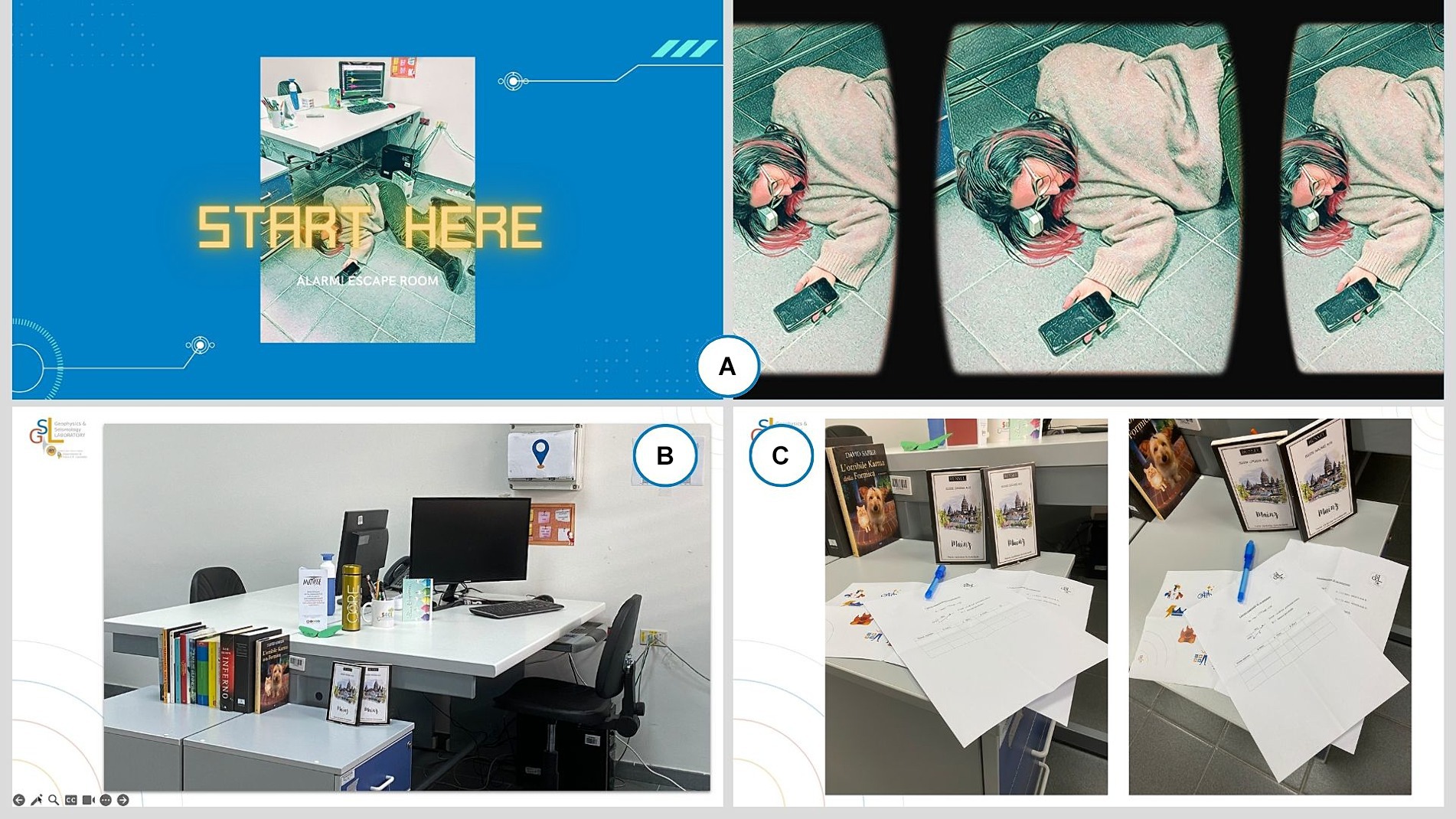
Figure 3. Examples of the activities consisting of interactive puzzles and riddles with a “seismic” theme that must be completed to get hints for resolving the larger problems. (A) Two photograms of the intro video, (B) room setting, (C) example of hints.
The Canva.com platform (CANVA Pty Ltd) was used to develop the clues and graphics of the escape room, while the software SeisGram2K (Lomax and Michelini, 2009) was employed for the seismogram interactive visualisation and analysis necessary for the earthquake location and magnitude estimation. Canva is a free-to-use online graphic design platform that empowers users to create a wide range of visual content, from social media posts and presentations to websites and merchandise, through its extensive library of templates, design tools, and features.
The escape room can be hosted in any video conferencing platform that provides screen sharing (we used Google Meet, Zoom, and Microsoft Teams).
We repeated the activity in different contests that were adapted to the coeval regulation in Italy, according, for instance, to the different pandemic waves and lockdowns in the regions and in the Country. The optimal solution, in our view, is for the technician to be connected from both a computer and a mobile device that reproduces his or her view, so that the latter can be used as an investigation tool by the players. If this is not possible, a slide deck with photos of the seismic room and its details should be created. In the second case, it is also possible to encourage interaction with the students, especially if the house is large, using online surveys (Zoom, Slido, etc.) to instruct the operator.
Finally, the main tasks were also solved using shared spreadsheets that allowed players to detect and manipulate data in first person even without the help of the operator.
At the end of the escape room, participants receive a certificate of thanks confirming to them that through their activities the relief efforts were able to help the affected populations.
2.3 Evaluation
Evaluating science communication activities is crucial to ensure their effectiveness in engaging stakeholders and the public, fostering informed decision-making, and promoting scientific literacy (Jensen and Gerber, 2020). Through evaluation, the impact of science communication initiatives can be assessed, leading to improvements in communication strategies, increased transparency, and the alignment of activities with societal values and needs (Jensen and Gerber, 2020). This process of evaluation not only enhances the quality and relevance of science communication but also contributes to building a more evidence-based approach in the field, bridging the gap between research and practise for more impactful communication outcomes (Jensen and Gerber, 2020). In order to evaluate our activities, we followed a similar rationale to the one used by Veldkamp et al. (2021) in their study aimed to assess the educational potential of escape rooms in science secondary education. The theoretical framework guiding this evaluation is rooted in the concept of experiential learning, which emphasises the importance of hands-on, interactive experiences in the learning process (Veldkamp et al., 2021). Based on their work, we developed a questionnaire designed to capture students’ perceptions of the escape room activity, including their experiences, opinions about the educational goals, and the usability of escape rooms in terms of learning outcomes. Additional, qualitative classroom observations were used to increase the internal validity of the study and provide a comprehensive understanding of the educational potential of escape rooms. Such evaluation was used in the interpretation of the quantitative data from the surveys.
Thus, before and after the practices, students and teachers were submitted a form (Appendix A) to assess, on the one hand, the preliminary status of knowledge and interest and the expectation on the experience; on the other hand, the impact of the event. Data were collected using anonymisation, furthermore no personal sensitive data (age, gender, religion, etc.) were used and collected if not in aggregated form. Nobody was obliged to respond to any of the questions if it could in any sense offended them.
The evaluation form consisted of multiple choice, Likert scales and open questions.
The Likert scale (Likert, 1932) is a psychometric scale commonly used to derive the attitude towards the given object, event, or concept. Respondents make a choice on a numerical scale that we set from 1 to 5.
While the multiple choice and the open questions were used to allow more personal inputs which were considered as qualitative results of the investigation.
A test group experienced the protocol reversed, i.e., virtual escape room followed by the frontal lecture, to evaluate the effect of the inversion.
To assess whether the pupils have assimilated the concepts proposed in the protocol, it is useful to evaluate the statistical correlation of the answers before and after the experience, via a t-Student test (Student, 1908) with a hypothesis on the significance of the distribution difference. In fact, 99% probability and 112 degrees of freedom corroborates the significance of all the mean values differences of the answers before and after the training section. To ensure internal consistency of data and retrieve how closely related a set of variables is as a single indicator, we verified the Cronbach alpha of all the data sets. Such a measure allows us to use the mean values of the Likert scales to compare the before and after results. Finally, the effect of the inversion on the test group was investigated via a Chi Quadro test, with a rejection of the null hypothesis for p < 0.05.
3 Results and discussion
The data analysed in this paper were collected during the 2021/22 edition of the Piano Lauree Scientifiche – PLS (Scientific Degree Plan) at the department of Physics “E.R. Caianiello” of the University of Salerno. The PLS was activated in 2004 by the Italian Ministry of Education, University and Scientific Research. The program objectives are the dissemination of scientific culture, the encouragement of young people to undertake the study of scientific subjects and the improvement of orientation possibilities through initiatives that offer the opportunity to have a first direct experience with the world of STEM (Science, Technology, Engineering and Mathematics) research. 112 students participated in ALARM of which 15 experienced the protocol reversed, that is frontal lecture after the escape room.
Figure 4 displays the main qualitative characteristics of the students. The pie charts show that 90% of the students are 16 and 17, with almost twice as many girls as boys. It is also clear that most of the students were not familiar with recreational or educational escape rooms before this experience.
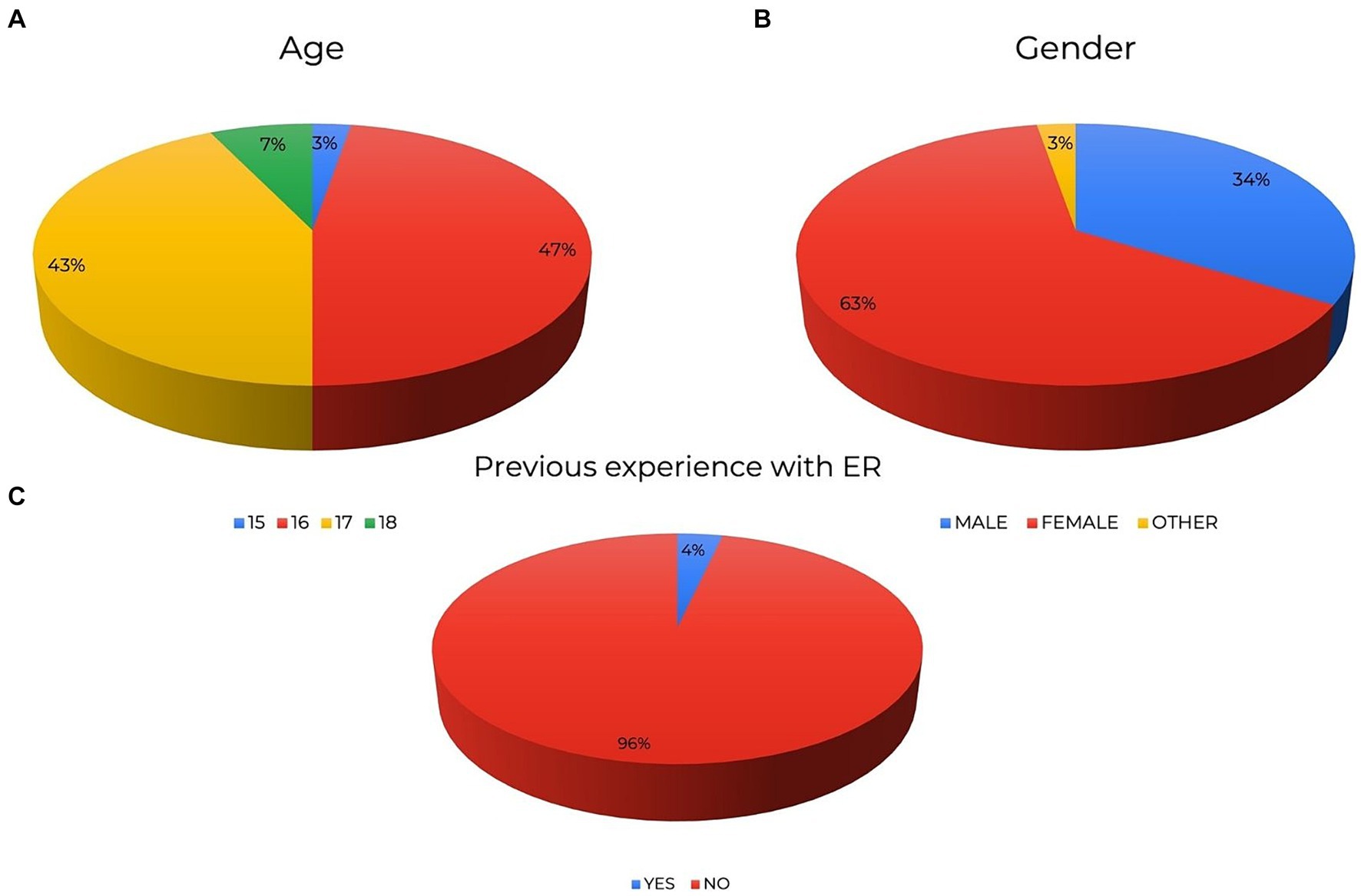
Figure 4. Pie chart of (A) Age distribution of the students; (B) Gender distribution of the students; (C) Students’ previous experience with Escape Rooms.
Among the 4% of the students who had previously participated in a Virtual Escape Room, only 1 had joined a recreational one, the rest had already experienced a didactic/educative one.
To ensure internal consistency of data and retrieve how closely related is a set of variables of as a single indicator, we verified the Cronbach alpha, of all the data sets, i.e., Group 1 – pupils who experienced the direct protocol; Group 2 – pupils who experienced the inverse protocol; Group 3 – all the pupils; Group 4–15 randomly selected pupils from Group 1.
As shown in Table 1, the obtained results (Cronbach alpha > 0.70) indicate a large correlation and large consistency between the indicators (Cronbach, 1951).
Such measures have allowed us to use the mean values of the Likert scales to compare the before and after results.
3.1 Headings pre vs. post: Group 3
In the following we will display the result obtained by confronting the pre and post evaluation for Group 3: all the pupils.
3.1.1 Quantitative results
Figures 5–8 show the distribution of the answers to the control questions before and after the protocol for Group 3. Likert scale was set from1 to 5, as shown in Appendix A.
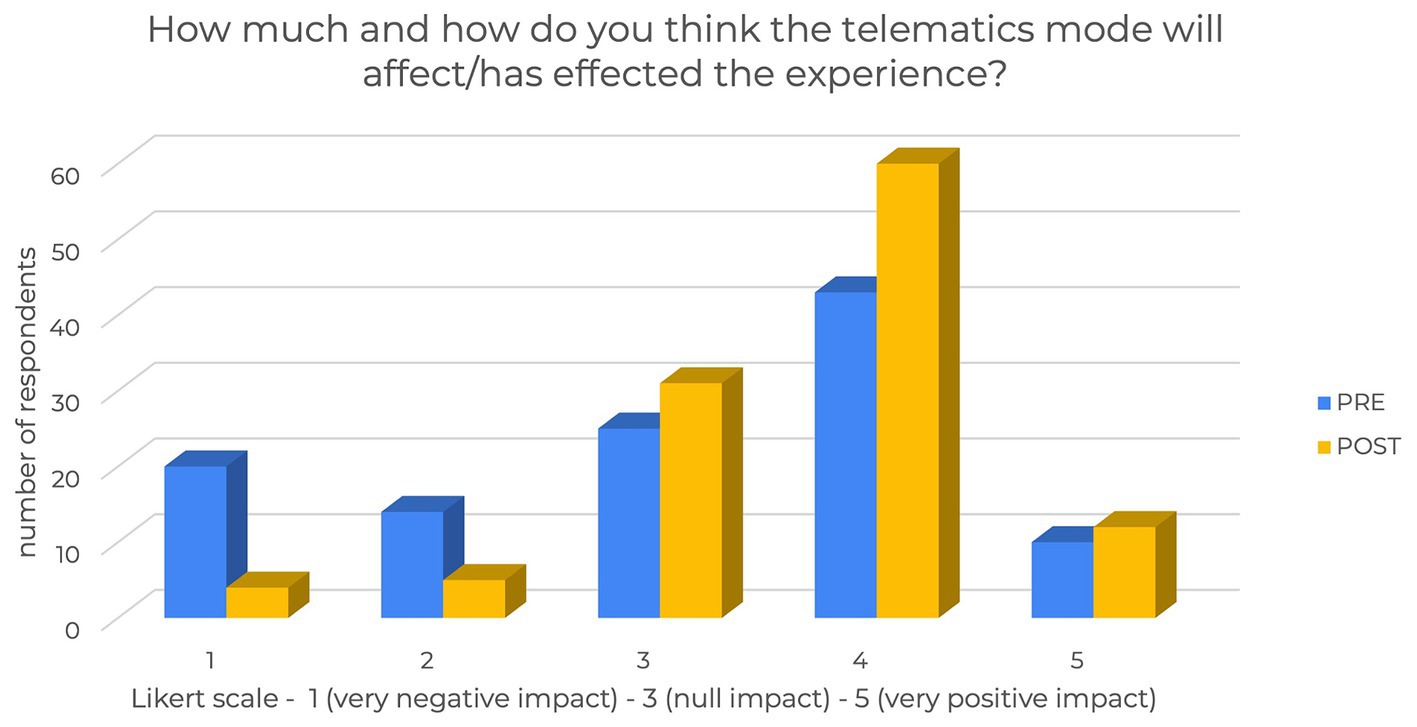
Figure 5. Question A – how much and how do you think the telematics mode will affect the experience? The y-axis represents the number of respondents for each option while the x-axis shows the Likert scale.
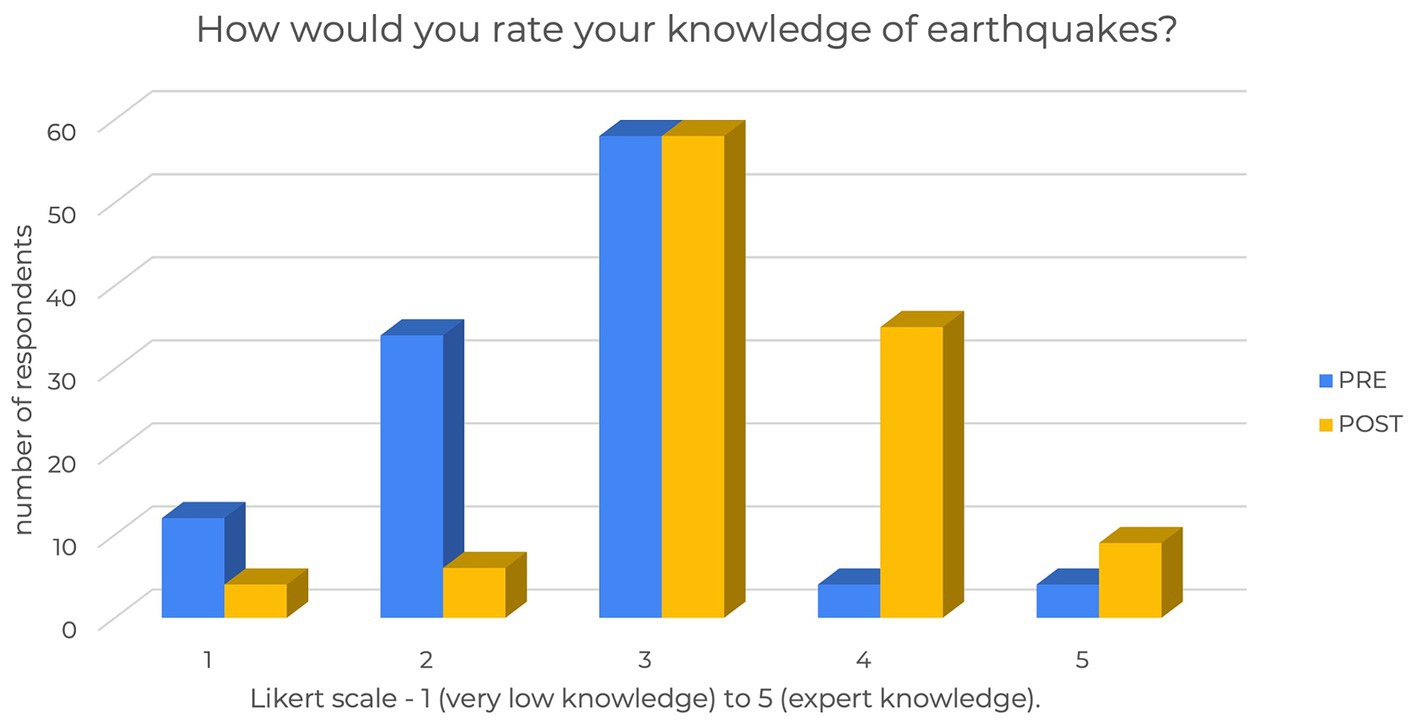
Figure 6. Results form Question B – how would you rate your knowledge of earthquakes? The y-axis represents the number of respondents for each option while the x-axis shows the Likert scale.
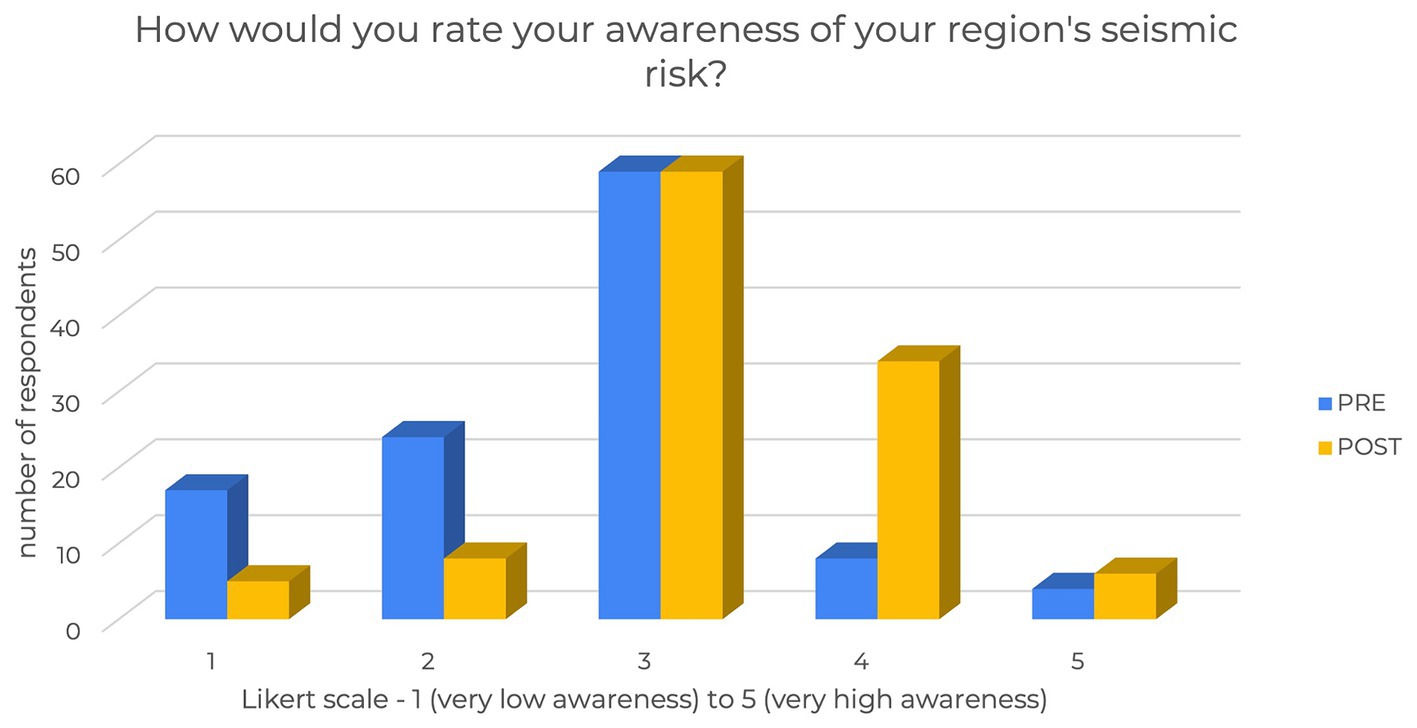
Figure 7. Results form Question C – how would you rate your awareness of your region’s seismic risk? The y-axis represents the number of respondents for each option while the x-axis shows the Likert scale.
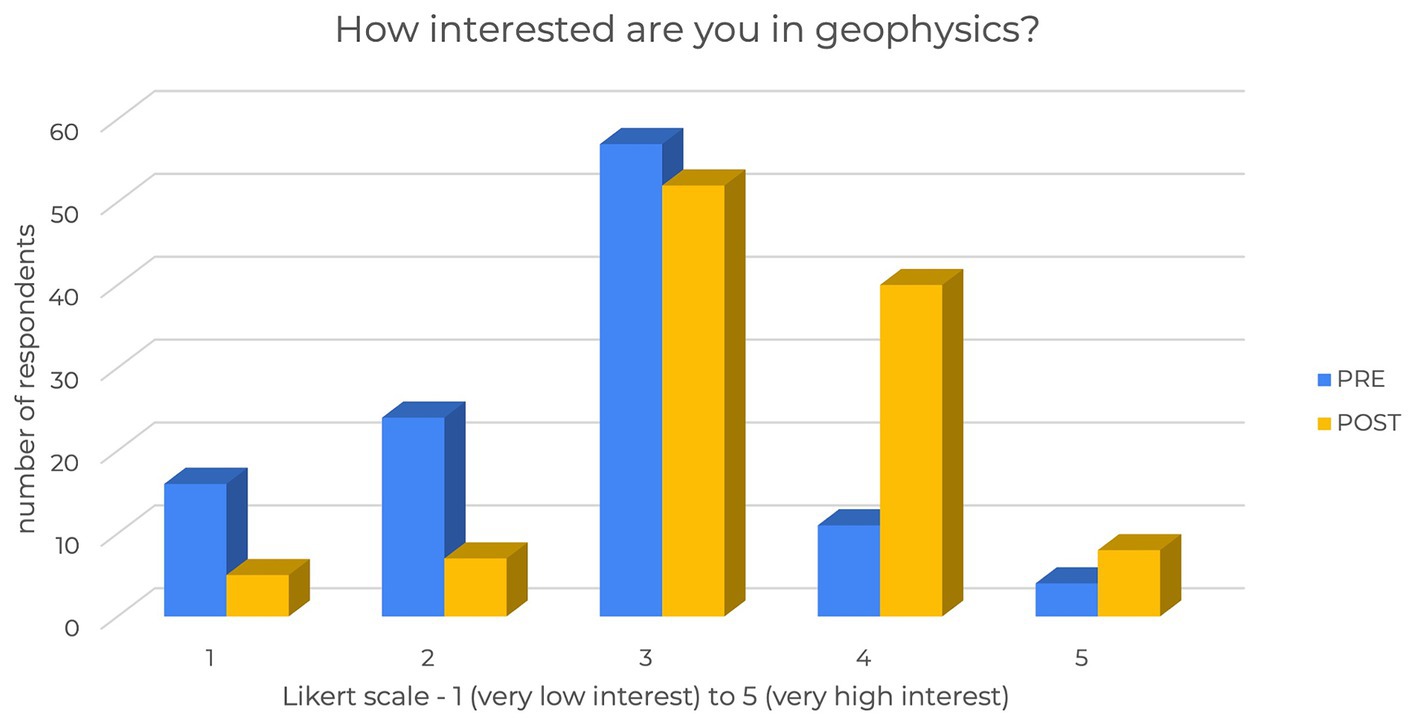
Figure 8. Results form Question D – how interested are you in geophysics? The y-axis represents the number of respondents for each option while the x-axis shows the Likert scale.
These figures show a right shift in the distributions of the answers, that would imply a positive impact of the protocol. To verify such assumption and, thus, to assess whether the pupils have assimilated the concepts proposed in the protocol, we evaluated the statistical correlation of the answers before and after the experience, via a t-Student test with a hypothesis on the significance of the distribution difference for Group 3. The results are shown in Table 2.
For all the questions in exam the test results in the rejection of the null hypothesis with 99% probability (p < 0.01) and 112 degrees of freedom, corroborating that there is a significant divergence between the two distributions, i.e., pre and post protocol.
It is interesting to see what this difference implies for each question.
3.1.1.1 Question A – how much and how do you think the telematics mode will affect the experience?
The Likert scale was set from 1 (very negative impact) to 5 (very positive impact). The pre protocol mean value is set on 3 (null impact) while the post protocol mean value is 3.6 (null to positive impact).
This might hint to the fact that the use of the Escape Room, which would not be possible in a live setting with the same amount of people, was considered as a positive feature.
3.1.1.2 Question B – how would you rate your knowledge of earthquakes?
The Likert scale was set from 1 (very low knowledge) to 5 (expert knowledge). The pre protocol mean value is set on 2,6 (lower than average) while the post protocol mean value is 3.3 (higher than average).
This hints to the fact that the students perceived the protocol as effective and a learning experience.
3.1.1.3 Question C – how would you rate your awareness of your region’s seismic risk?
The Likert scale was set from 1 (very low awareness) to 5 (very high awareness). The pre protocol mean value is set on 2,6 (lower than average) while the post protocol mean value is 3.3 (higher than average).
This hints to the fact that the students perceived the protocol as effective in communicating the concept of seismic risk. Please note that the question evaluates one’s own perception of awareness, which is not necessarily a measure of the actual knowledge/awareness.
3.1.1.4 Question D – How interested are you in geophysics?
The Likert scale was set from 1 (very low interest) to 5 (very high interest). The pre protocol mean value is set on 2,7 (low to null interest) while the post protocol mean value is 3.3 (null to high interest).
This hints to the fact that the protocol had a positive impact on the pupils’ interest in science and geophysics.
3.1.2 Qualitative results
The post protocol questionnaire had three more questions, whose answer we report in the following.
To test the students’ perception of their own learning in the overall experience, we asked them about what educational goals they thought they achieved with the escape room. Figure 9 shows the results. It was possible for the students to select more than one answer.
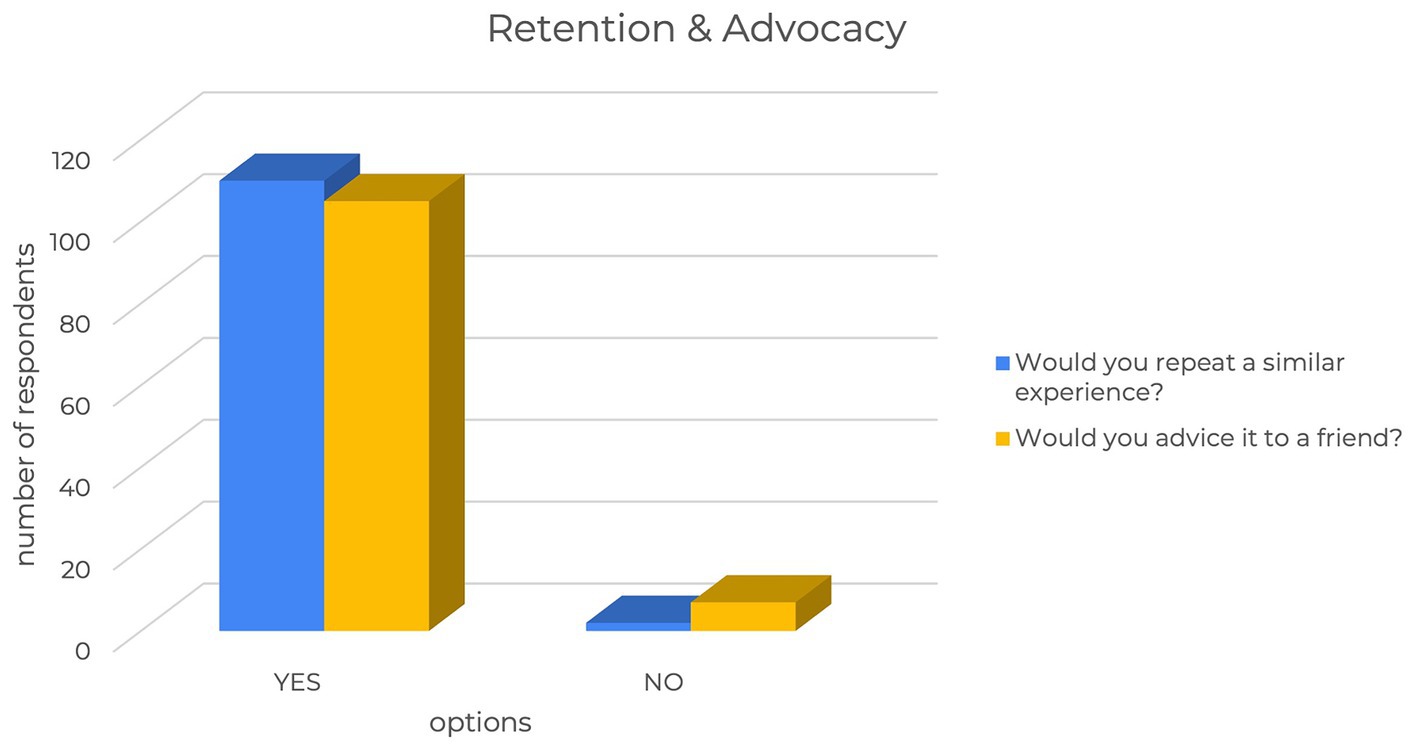
Figure 9. Results form Question E – what do you think were the educational goals achieved with the escape room? A1:Acquire new content knowledge and skills; A2:Elaborate on content knowledge and skills; A3: Testing content knowledge and skills; A4:Formative assessment; A5:Improve teamwork; A6:Improve motivation for geophysics; A7:Get to know each other; A8:Other Objective(s).
Students perceived the overall experience as positive not only in the acquisition of new content knowledge and skills but also in elaborating and testing on previous and acquired ones.
Around 20% of the pupils have also found the experience as team building and as a booster in the motivation to further undergo studies of geophysics. A little more than 5% of the students have found the experience as a formative assessment.
Moreover, to test the likeability of the protocol for, we used standard marketing questions for retention and advocacy considering our protocol and “the product.” Figure 9 shows that the protocol obtained a 98% of retention and a 94% of advocacy.
3.2 Direct vs. inverse protocol: Group 2 and 4
In the following we will display the result obtained by confronting the direct and inverse protocol post evaluation for Group 2 – pupils who experienced the inverse protocol – and Group 4–15 randomly selected pupils from the ones who were subject to the direct protocol.
We applied the Chi Quadro test to Group 2 and 4, with a rejection of the null hypothesis for p < 0.05 (95%). Table 3 shows the results.
Both tests fail to reject the null hypothesis with the significance we have chosen to be valid (95%) and therefore it is not possible to conclude that the two distributions (for each question) significantly differ (Figure 10).
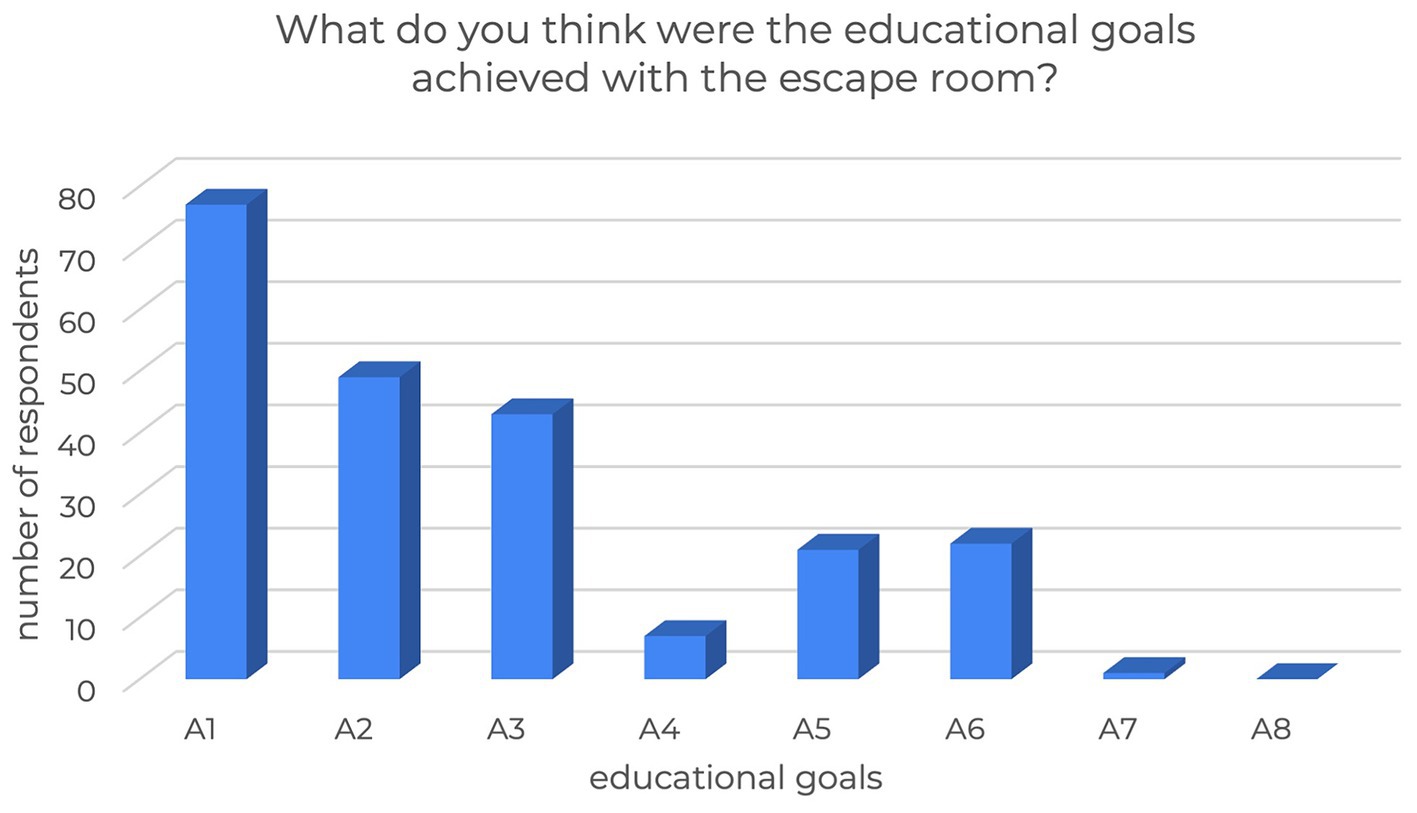
Figure 10. Results form Question F: would you repeat a similar experience? and Question G: would you advise it to a friend?
3.3 Remarks
It is important to notice that with the questionnaire we defined, the only way one can assess the raising of awareness is through the link with knowledge. In fact, it plays a crucial role in shaping our awareness and perception of the world around us (Bransford et al., 2000). Our current base of information establishes the framework through which we interpret and make sense of the sensory inputs we receive. This knowledge, accumulated through education, experience, and socialisation, influences what we pay attention to, how we interpret the information we encounter, and the significance we attribute to different stimuli (Bransford et al., 2000).
Research has shown that prior knowledge can act as a lens, guiding our attention and perception (Sternberg, 2003). Individuals with more extensive knowledge in a particular domain tend to notice and recognize relevant information more readily, while those with less knowledge may overlook or misinterpret the same cues (Simons and Chabris, 1999). This selective attention and interpretation can have significant implications for decision-making, problem-solving, and overall understanding of the world (Kahneman, 2011).
Furthermore, the way we organise and structure our knowledge can also shape our awareness (Sternberg, 2003). Cognitive frameworks, such as schemas and mental models, provide a means of organising and interpreting information, allowing us to make sense of complex phenomena and draw inferences. These knowledge structures influence how we perceive and respond to new information, often leading to biases and preconceptions that can be difficult to overcome (Rumelhart, 1980).
Another important aspect to take into consideration is that the occurrence of an overwhelming hazard, such as the COVID-19 pandemic, has been shown to significantly influence students’ participation, willingness to seek information, and proactivity towards risk reduction (Dryhurst et al., 2020; Zhong et al., 2020). Research indicates that the disruption and uncertainty caused by the pandemic can lead to increased anxiety, stress, and feelings of helplessness among students, which can negatively impact their engagement and motivation (Cao et al., 2020; Elmer et al., 2020). However, studies have also found that students who receive timely and accurate information about the hazard and risk mitigation strategies are more likely to exhibit proactive behaviours, such as adopting preventive measures and participating in risk reduction activities (Dryhurst et al., 2020). Effective risk communication and the provision of accessible resources can empower students to take an active role in protecting themselves and their communities, fostering a sense of agency and resilience in the face of overwhelming challenges (Dryhurst et al., 2020).
4 Conclusion
Science communication is of fundamental importance, and it can be crucial in implanting the culture of risk and fighting the mistrust towards science that is rising in this historical period (Algan et al., 2021).
Targeting kids and students can have a double impact. In fact, the younger generation plays a key role in the scientific awareness of society, representing both the future of the belonging community and a conduit to reach and educate their families.
Our aim was to create a protocol that could be applied for different topics (not only for seismology) and in different contexts but with the specific intention to increase and test students’ capabilities towards the taught concepts during the ludic experience.
We thus developed an ad hoc educational protocol dedicated to high school students (15–18+) that combined the theoretical phase with a seminar on the basic concepts of seismology and seismic risk education with a serious game that would allow students to assimilate the content while keeping the overall experience light and interactive, and the learning informal. Through the application of our evaluation protocol, we successfully gauged the effectiveness of our approach in conveying and educating individuals on the subject of seismic risk. This evaluation encompassed an assessment of its influence on both risk perception and the level of interest generated in the realms of science and geophysics.
The results are very encouraging and suggest that some students perceived the protocol as effective, finding value in the activity for learning basic concepts of seismology and developing their awareness of seismic risk. The protocol had a weak but nonetheless positive impact on the pupils’ interest in science and geophysics. Among the qualitative answers of the evaluation forms, in fact, many students referred to the realisation of how close this topic or science in general is to everyday life, hinting at a growth in the Science Capital of the participants.
We also investigated the effect of an inversion in the protocol, i.e., the Escape Room was played before the seminar, allowing the pupils to experience first what they would learn later. In this case the results were, as expected, not significant. On one hand, in fact, our protocol is too short to allow a full development of an Inquiry Based Learning (IBL) methodology, on the other hand, the test group with which we were able to test the inversion was little. For these reasons, a deeper investigation of the inversion consequences could be a future step of this research.
In our experience, thus, one-shot activities can effectively raise awareness by providing individuals with a unique and impactful encounter that stands out in their memory, potentially leading to increased attention and understanding of the subject matter. Combining this one-shot experience with other longer ones can highlight the significance and importance of the information conveyed, further enhancing awareness and retention. Serious games dedicated to seismic risk offer an interactive and engaging approach to educating individuals about earthquake preparedness and mitigation strategies. These games can be integrated into existing educational curricula to enhance learning outcomes and foster a deeper understanding of seismic risks among students (Musacchio et al., 2021). However, it is essential to acknowledge the limitations of such approaches, including the need for ongoing evaluation of their effectiveness, adaptability to different educational settings, and consideration of diverse learning styles. Future research directions could focus on exploring the long-term impact of serious games on students’ knowledge retention and behavioural changes, as well as investigating the optimal design elements and implementation strategies for integrating serious games into formal education settings (Musacchio et al., 2021). A roadmap for subsequent inquiries in this field could involve conducting longitudinal studies to assess the sustained effects of serious games on seismic risk awareness and preparedness, as well as exploring innovative ways to enhance the scalability and accessibility of serious games for broader educational use. In this sense, another possible future step to enhance the effectiveness of the protocol would be retesting the participants, with their families, at different times after the protocol, this could suggest a way forward to improve inclusive science communication techniques.
In our beliefs, one of the factors that helped the success of the protocol was the age of the selected target. In fact, the developed puzzles and the discussed topics need a level of consciousness of both mathematics and logic that is generally developed in high school (Ojose, 2008; Kikas et al., 2009; Lefa, 2014) Another interesting feature, that we did not expect, of our experiment is that the majority of our pool is female. We think it would be worthwhile to further investigate such a feature and its impacts on the effect of the protocol in future developments.
Another possible feature to investigate is how the number of simultaneous participants impacts on the efficacy of the protocol. In our case, we had from 15 to 60 simultaneous participants that were active in the experience via a pool software. It could be interesting to evaluate whether reducing the pool of participants and allowing them a more direct interaction would improve the efficacy of the protocol.
In conclusion, the conceived protocol seems to be successful. However, in the future we will move some steps forward by investigating the above-mentioned aspects such as the gender implications, the inclusion of tested pupils’ families and so on. The future investigation will possibly take into account socio-economic context and psychological factors possible influencing the results.
Data availability statement
The raw data supporting the conclusions of this article will be made available by the authors, without undue reservation.
Ethics statement
Ethical approval was not required for the study involving humans in accordance with the local legislation and institutional requirements. Written informed consent for participation in this study was provided by the participants' legal guardians/next of kin.
Author contributions
MG: Conceptualization, Data curation, Formal analysis, Investigation, Methodology, Writing – original draft, Writing – review & editing. FN: Conceptualization, Methodology, Writing – review & editing. OA: Conceptualization, Methodology, Writing – review & editing. RR: Formal analysis, Funding acquisition, Methodology, Writing – review & editing. PC: Funding acquisition, Resources, Supervision, Writing – review & editing, Data curation, Project administration.
Funding
The author(s) declare that financial support was received for the research, authorship, and/or publication of this article. This work has been partially supported by the project CORE – sCience and human factor for Resilient SociEty founded by the European Union’s Horizon 2020 research and innovation program under grant agreement No 101021746 and by the project TOGETHER - Sustainable geothermal energy for two Southern Italy regions: geophysical resource evaluation and public awareness financed by European Union – Next Generation EU (PRIN-PNRR 2022, CUP D53D23022850001, Mission 4 “Istruzione e Ricerca-Componente C2 Investimento 1.1”).
Acknowledgments
We acknowledge the Piano Lauree Scientifiche Committee of the Dipartimento di Fisica “E.R. Caianiello” of the University of Salerno for allowing us to collect the data analysed in this paper were collected during the 2021/22 edition of the Piano Lauree Scientifiche – PLS (Scientific Degree Plan). We would also like to express gratitude to the reviewers whose feedback contributed to improving the final outcome of this work.
Conflict of interest
The authors declare that the research was conducted in the absence of any commercial or financial relationships that could be construed as a potential conflict of interest.
The author(s) declared that they were an editorial board member of Frontiers, at the time of submission. This had no impact on the peer review process and the final decision.
Publisher’s note
All claims expressed in this article are solely those of the authors and do not necessarily represent those of their affiliated organizations, or those of the publisher, the editors and the reviewers. Any product that may be evaluated in this article, or claim that may be made by its manufacturer, is not guaranteed or endorsed by the publisher.
Supplementary material
The Supplementary material for this article can be found online at: https://www.frontiersin.org/articles/10.3389/fcomm.2024.1386674/full#supplementary-material
Footnotes
References
Alexander, D. E. (2014). Communicating earthquake risk to the public: the trial of the “L’Aquila seven”. Nat. Hazards 72, 1159–1173. doi: 10.1007/s11069-014-1062-2
Algan, Y., Cohen, D., Davoine, E., Foucault, M., and Stantcheva, S. (2021). “Trust in scientists in times of pandemic: Panel evidence from 12 countries.” in Proceedings of the National Academy of Sciences. 118:e2108576118. doi: 10.1073/pnas.2108576118
Appleby-Arnold, S., Brockdorff, N., and Callus, C. (2021). Developing a “culture of disaster preparedness”: the citizens’ view. Int. J. Disaster Risk Reduct. 56:102133. doi: 10.1016/j.ijdrr.2021.102133
Bransford, J. D., Brown, A. L., and Cocking, R. R. (Eds.). (2000). How people learn: Brain, mind, experience, and school. National Academy Press.
Cain, J. (2019). Exploratory implementation of a blended format escape room in a large enrollment pharmacy management class. Curr. Pharm. Teach. Learn. 11, 44–50. doi: 10.1016/j.cptl.2018.09.010
Cao, W., Fang, Z., Hou, G., Han, M., Xu, X., Dong, J., et al. (2020). The psychological impact of the COVID-19 epidemic on college students in China. Psychiatry Res. 287:112934. doi: 10.1016/j.psychres.2020.112934
Chmutina, K., and von Meding, J. (2019). A dilemma of language: "natural disasters" in academic literature. Int. J. Disaster Risk Sci. 10, 283–292. doi: 10.1007/s13753-019-00232-2
Coombs, W. T., and Holladay, S. J. (2012). The handbook of crisis communication. Malden, MA, USA: Wiley-Blackwell.
Coppola, D. P. (2015). Introduction to international disaster management. Burlington, MA, USA: Butterworth-Heinemann.
Crescimbene, M., La Longa, F., Camassi, R., Pino, N. A., and Peruzza, L. (2018). Seismic risk perception in Italy. Ann. Geophys. 61:SE226. doi: 10.4401/ag-7814
Cronbach, L. J. (1951). Coefficient alpha and the internal structure of tests. Psychometrika 16, 297–334. doi: 10.1007/BF02310555
Dallo, I., Elroy, O., Fallou, L., Komendantova, N., and Yosipof, A. (2023). Dynamics and characteristics of misinformation related to earthquake predictions on twitter. Sci. Rep. 13:13391. doi: 10.1038/s41598-023-40399-9
Dryhurst, S., Mulder, F., Dallo, I., Kerr, J. R., McBride, S. K., Fallou, L., et al. (2022). Fighting misinformation in seismology: expert opinion on earthquake facts vs. fiction. Front. Earth Sci. 10:937055. doi: 10.3389/feart.2022.937055
Dryhurst, S., Schneider, C. R., Kerr, J., Freeman, A. L. J., Recchia, G., van der Bles, A. M., et al. (2020). Risk perceptions of COVID-19 around the world. J. Risk Res. 23, 994–1006. doi: 10.1080/13669877.2020.1758193
Elmer, T., Mepham, K., and Stadtfeld, C. (2020). Students under lockdown: comparisons of students' social networks and mental health before and during the COVID-19 crisis in Switzerland. PLoS One 15:e0236337. doi: 10.1371/journal.pone.0236337
Falsaperla, S., Reitano, D., and Musacchio, G. (2022). Augmented reality in seismic risk management: a contribution to the reduction of non-structural damage. Geosciences 12:332. doi: 10.3390/geosciences12090332
Federal Emergency Management Agency (2009). "Building Science: Compliance with Building Codes." FEMA P-424, Design Guide for Improving School Safety in Earthquakes, Floods, and High Winds. Available at: https://www.fema.gov/media-library/assets/documents/5264
Fernandez, M., and Alani, H. (2018). “Online misinformation: challenges and future directions.” in Companion proceedings of the the web conference 2018 (WWW '18). International World Wide Web Conferences Steering Committee, Republic and Canton of Geneva, CHE. pp. 595–602.
Fernandez, G., and Shaw, R. (2013). Youth council participation in disaster risk reduction in Infanta and Makati, Philippines: a policy review. Int. J. Disaster Risk Sci. 4, 126–136. doi: 10.1007/s13753-013-0014-x
Filomena, M. G., Pace, B., De Acetis, M., Aquino, A., Crescimbene, M., Pace, M., et al. (2023). Play to learn: a game to improve seismic-risk perception. Sustain. For. 15:4639. doi: 10.3390/su15054639
Fotaris, P., and Mastoras, T. (2019). “Escape rooms for learning: a systematic review.” in Proceedings of the 13th international conference on game based learning, ECGBL 2019. pp. 235–243. Academic Conferences and Publishing International Limited.
Havskov, J., and Ottemöller, L. (2010) Routine data processing in earthquake seismology with sample data, exercises and software. Springer Dordrecht Heidelberg: London, New York.
Jensen, E. A., and Gerber, A. (2020). Evidence-based science communication. Front. Commun. 4:78. doi: 10.3389/fcomm.2019.00078
Jun, S. P., Yoo, H. S., and Lee, C. (2021). Young people are not blameworthy: the generation’s awareness of COVID-19 and behavioral responses. Sci. Rep. 11:14417. doi: 10.1038/s41598-021-03036-x
Kapucu, N. (2008). Collaborative emergency management: better community organising, better public preparedness and response. Disasters 32, 239–262. doi: 10.1111/j.1467-7717.2008.01037.x
Katsikopoulos, P. V. (2021). Individual and community resilience in natural disaster risks and pandemics (Covid-19): risk and crisis communication. Mind Soc 20, 113–118. doi: 10.1007/s11299-020-00254-0
Kikas, E., Peets, K., Palu, A., and Afanasjev, J. (2009). The role of individual and contextual factors in the development of maths skills. Educ. Psychol. 29, 541–560. doi: 10.1080/01443410903118499
Kinio, A. E., Dufresne, L., Brandys, T., and Jetty, P. (2019). Break out of the classroom: the use of escape rooms as an alternative teaching strategy in surgical education. J. Surg. Educ. 76, 134–139. doi: 10.1016/j.jsurg.2018.06.030
Krath, J., Schürmann, L., and von Korflesch, H. F. O. (2021). Revealing the theoretical basis of gamification: a systematic review and analysis of theory in research on gamification, serious games and game-based learning. Comput. Hum. Behav. 125, 106963–105632. doi: 10.1016/j.chb.2021.106963
Lathwesen, C., and Belova, N. (2021). Escape rooms in STEM teaching and learning - prospective field or declining trend? A literature review. Educ. Sci. 11:308. doi: 10.3390/educsci11060308
Lazer, D. M. J., Baum, M. A., Benkler, Y., Berinsky, A. J., Greenhill, K. M., Menczer, F., et al. (2018). The science of fake news. Science 359, 1094–1096. doi: 10.1126/science.aao2998
Lefa, B. (2014). The Piaget theory of cognitive development: an educational implications. Educ. Psychol.
Lewandowsky, S., Ecker, U. K. H., and Cook, J. (2017). Beyond misinformation: understanding and coping with the “post-truth” era. J. Appl. Res. Mem. Cognition 6, 353–369. doi: 10.1016/j.jarmac.2017.07.008
Lewandowsky, S., and van der Linden, S. (2021). Countering misinformation and fake news through inoculation and prebunking. Eur. Rev. Soc. Psychol. 32, 348–384. doi: 10.1080/10463283.2021.1876983
Lomax, A., and Michelini, A. (2009). Mwpd: a duration-amplitude procedure for rapid determination of earthquake magnitude and Tsunamigenic potential from P waveforms. Geophys. J. Int. 176, 200–214. doi: 10.1111/j.1365-246X.2008.03974.x
López-Belmonte, J., Segura-Robles, A., Fuentes-Cabrera, A., and Parra-González, M. E. (2020). Evaluating activation and absence of negative effect: gamification and escape rooms for learning. Int. J. Environ. Res. Public Health 17:2224. doi: 10.3390/ijerph17072224
Meesters, K., and Van Aalst, M. (2014). The role of interactive community mapping in supporting disaster response, recovery and risk reduction. Proc. Eng. 78, 112–119. doi: 10.1016/j.proeng.2014.07.046
Mitchell, T., Haynes, K., Hall, N., Choong, W., and Oven, K. (2008). The roles of children and youth in communicating disaster risk. Child. Youth Environ. 18, 254–279. doi: 10.1353/cye.2008.0036
Musacchio, G., Eva, E., Crescimbene, M., Pino, N. A., and Cugliari, L. (2021). A protocol to communicate seismic risk in schools: design, test and assessment in Italy. Ann. Geophys. 64:SE325. doi: 10.4401/ag-8533
Musacchio, G., Eva, E., and Piangiamore, G. L. (2019). "The KnowRISK action for schools: a case study in Italy". in Proceedings of the International Conference on Earthquake Engineering and Structural Dynamics. ICESD 2017. eds. Rupakhety, R. Olafsson, S. Bessason, B. Geotechnical, Geological And Earthquake Engineering (Springer) 47, 459–470.
Musacchio, G., Falsaperla, S., Bernhardsdóttir, A. E., Ferreira, M. A., Sousa, M. L., Carvalho, A., et al. (2016). Education: can a bottom-up strategy help for earthquake disaster prevention? Bull. Earthq. Eng. 14, 2069–2086. doi: 10.1007/s10518-015-9779-1
Musacchio, G., Piangiamore, G. L., D’Addezio, G., Solarino, S., and Eva, E. (2015). “Scientist as a game”: learning geoscience via competitive activities. Ann. Geophys. 58:5. doi: 10.4401/ag-6695
Musacchio, G., Saraò, A., Falsaperla, S., and Scolobig, A. (2023). A scoping review of seismic risk communication in Europe. Front. Earth Sci. 11:1155576. doi: 10.3389/feart.2023.1155576
Nicholson, S. (2015). Peeking behind the locked door: a survey of escape room facilities. White Paper. Available at http://scottnicholson.com/pubs/erfacwhite.pdf
Nicholson, S. (2018). Creating engaging escape rooms for the classroom. Child. Educ. 94, 44–49. doi: 10.1080/00094056.2018.1420363
Ojose, B. (2008). Applying Piaget’s theory of cognitive development to mathematics instruction. TME 18, 26–30.
Paton, D. (2019). Disaster risk reduction: psychological perspectives on preparedness. Aust. J. Psychol. 71, 327–341. doi: 10.1111/ajpy.12237
Piangiamore, G. L., Falsaperla, S., Eva, E., and Musacchio, G. (2021). Seismic risk communication let’s students show their own way. Ann. Geophys. 63:4. doi: 10.4401/ag-8396
Reitano, D., Falsaperla, S., Musacchio, G., and Merenda, R. (2019). "Awareness on seismic risk: how can augmented reality help". in Proceedings of the International Conference on Earthquake Engineering and Structural Dynamics. ICESD 2017, eds. Rupakhety, R. Olafsson, S. Bessason, B. Geotechnical, geological and earthquake engineering (Springer) 47, 485–492.
Reuter, C., Kaufhold, M. A., Schmid, S., Spielhofer, T., and Hahne, A. S. (2019). The impact of risk cultures: Citizens' perception of social media use in emergencies across Europe. Technol. Forecast. Soc. Change 148:119724. doi: 10.1016/j.techfore.2019.119724
Reuter, C., and Spielhofer, T. (2017). Towards social resilience: a quantitative and qualitative survey on citizens' perception of social media in emergencies in Europe. Technol. Forecast. Soc. Change 121, 168–180. doi: 10.1016/j.techfore.2016.07.038
Rumelhart, D. E. (1980). Schemata: The building blocks of cognition. In Theoretical Issues in Reading Comprehension. Eds. R. J. Spiro, B. C. Bruce, and W. F. Brewer (Erlbaum) pp. 33–58.
Simons, D. J., and Chabris, C. F. (1999). Gorillas in our midst: Sustained inattentional blindness for dynamic events. Percept. 28, 1059–1074. doi: 10.1068/p281059
Societal Resilience Cluster (2023). Strengthening Societal Resilience to Disasters: Improving Engagement and Communication among Citizens and Authorities
Solarino, S., Ferreira, M. A., Musacchio, G., and Eva, E. (2021). Playing games for risk prevention: design, implementation and testing of serious games in recent European projects UPStrat-MAFA and KnowRISK. Ann. Geophys. 63:8. doi: 10.4401/ag-8436
Spence, R. (2004). Risk and regulation: can improved government action reduce the impacts of natural disasters? Build. Res. Inf. 32, 391–402. doi: 10.1080/0961321042000221043
Tierney, K. J. (2019). Disaster myths, media frames, and their consequences: Post-katrina new orleans as a case study. J. Health Soc. Behav. 60, 377–392. doi: 10.1177/0022146519880380
Torpan, S., Hansson, S., Rhinard, M., Kazemekaityte, A., and Jukarainen, P., Meyer,S.F., Schieffelers, A., Lovasz, G., and Orru, K. (2021). Handling false information in emergency management: a cross-national comparative study of European practices. Int. J. Disaster Risk Red. 57, 102151–104209. doi: 10.1016/j.ijdrr.2021.102151
Veldkamp, A., Knippels, M. C. P. J., and van Joolingen, W. R. (2021). Beyond the early adopters: escape rooms in science education. Front. Educ. 6:622860. doi: 10.3389/feduc.2021.622860
Veldkamp, A., van de Grint, L., Knippels, M. C. P. J., and van Joolingen, W. R. (2020, 2020). Escape education: a systematic review on escape rooms in education. Educ. Res. Rev. 31:100364. doi: 10.1016/j.edurev.2020.100364
Wendling, C., Radisch, J., and Jacobzone, S. (2013, 2013). The use of social Media in Risk and crisis communication (OECD working papers on public governance No. 24, OECD work). Pap. Publ. Gover 24. doi: 10.1787/5k3v01fskp9s-en
Zhong, B. L., Luo, W., Li, H. M., Zhang, Q. Q., Liu, X. G., Li, W. T., et al. (2020). Knowledge, attitudes, and practices towards COVID-19 among Chinese residents during the rapid rise period of the COVID-19 outbreak: a quick online cross-sectional survey. Int. J. Biol. Sci. 16, 1745–1752. doi: 10.7150/ijbs.45221
Keywords: educational seismology, risk communication, seismic risk, science communication, serious games
Citation: Gargiulo MV, Napolitano F, Amoroso O, Russo R and Capuano P (2024) A didactic experience for educating the youngest generations about seismic risk using an escape room. Front. Commun. 9:1386674. doi: 10.3389/fcomm.2024.1386674
Edited by:
Caroline Orchiston, University of Otago, New ZealandReviewed by:
Chiara Scaini, National Institute of Oceanography and Applied Geophysics, ItalyGemma Musacchio, National Institute of Geophysics and Volcanology (INGV), Italy
Copyright © 2024 Gargiulo, Napolitano, Amoroso, Russo and Capuano. This is an open-access article distributed under the terms of the Creative Commons Attribution License (CC BY). The use, distribution or reproduction in other forums is permitted, provided the original author(s) and the copyright owner(s) are credited and that the original publication in this journal is cited, in accordance with accepted academic practice. No use, distribution or reproduction is permitted which does not comply with these terms.
*Correspondence: Maria Vittoria Gargiulo, bWdhcmdpdWxvQHVuaXNhLml0; Ortensia Amoroso, b2Ftb3Jvc29AdW5pc2EuaXQ=
 Maria Vittoria Gargiulo
Maria Vittoria Gargiulo Ferdinando Napolitano
Ferdinando Napolitano Ortensia Amoroso
Ortensia Amoroso Raffaella Russo
Raffaella Russo Paolo Capuano
Paolo Capuano